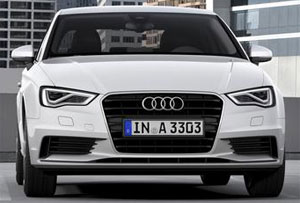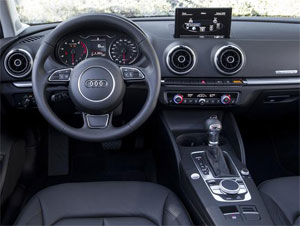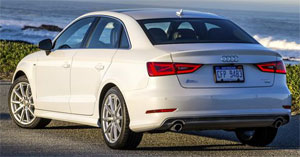2015 Audi A3
Entry-level German sports luxury cars are a tricky proposition here. Most Americans still tend to look at the big-3 German cars as premium items, and then they’re disappointed when they sample the more meat and potatoes compacts and subcompacts from the brand. Well that could be why the Audi A3 has never been a huge seller here. Or, it’s more likely that up to this point the A3 has only been available as a 5-door hatchback. Either way, there’s an all-new A3 sedan in town, and it’s arrives with the U.S.A. as its bull’s-eye.
The 2015 Audi A3 marks an important step for Audi. Proof that they are now taking the American and, perhaps more importantly, the world’s upscale small car market more seriously, spurred along by the recent success of the Mercedes-Benz CLA250.
After all, nothing says conventional like a subcompact sedan, but the A3 4-door is far from mainstream. And while making premium attainable is not a simple undertaking, it’s one that must be completed effectively in order for the A3 to be a success here. And it should be doable as Americans have long embraced the A4 sedan.
 Let’s get things started in the powertrain department, with a choice of 2 corporate Turbo I4s. A 1.8-liter with 170-horsepower and 200 lb-ft. of torque is found in front wheel drive models; and a 2.0-liter with 220-horsepower and 258 lb-ft. provides motivation to all 4 wheels in quattro models. Both come with a 6-speed S tronic dual-clutch automatic; no manual is available.
Let’s get things started in the powertrain department, with a choice of 2 corporate Turbo I4s. A 1.8-liter with 170-horsepower and 200 lb-ft. of torque is found in front wheel drive models; and a 2.0-liter with 220-horsepower and 258 lb-ft. provides motivation to all 4 wheels in quattro models. Both come with a 6-speed S tronic dual-clutch automatic; no manual is available.
Our sample sports the 2.0, which performed admirably at our test track. Quattro makes for a grippy, if a little sluggish, launch off the line; but adequately quick, as we hit 60 in 6.0– seconds flat. We very much welcomed the true dual-clutch transmission over a CVT; still shifts weren’t as quick as expected helping us complete the ¼-mile in 14.6–seconds at 96 miles-per-hour.
While Audi’s sporty DNA shines through, this is clearly not an S model as steering is stone dead. Still there’s a solid and stable feel with just enough of an enjoyable, light weight presence that encourages pushing hard; and the A3 behaves itself well.
An all-aluminum sub-frame with MacPherson struts handles suspension duties up front, with a 4-link setup in the rear with a steel cross member. Brakes are the same for either front or all-wheel-drive A3, with our quattro stopping in a good 124–feet from 60.
This all-new sedan body is built on Volkswagen’s fledgling MQB architecture. Just about every exterior dimension is increased over the previous hatchback. Wheelbase is up more than 2-inches to 103.8. Length and width also see meaningful gains.
 There’s nothing ground breaking with exterior design elements, however, as all recent Audi trademarks are in place, including the large Singleframe grille and LED daytime running lights. Both A3s ride on nice looking 17-inch 5-spoke alloy wheels.
There’s nothing ground breaking with exterior design elements, however, as all recent Audi trademarks are in place, including the large Singleframe grille and LED daytime running lights. Both A3s ride on nice looking 17-inch 5-spoke alloy wheels.
Inside, is a whole new look for the brand. There’s still a premium feel with leather seating and panoramic sunroof standard; but it’s a clear step down from the lavish landscapes of A6 and A8. The wide and flat, simplistic dash design features large circular air vents giving it a sporting, if retro, feel; until you see the very thin navigation screen rise out of the dash. In front of the driver is a 3-spoke steering wheel and plenty of info on the gauge screens.
All controls are driver oriented, and there’s an updated version of Audi’s MMI central control, which we like even more thanks to the new toggle switches and write on feature. Front seats are roomy and comfortable, and while the stretch in wheelbase does allow for more rear seat room, it’s still barely adequate. Trunk space is more than adequate, however, at 10.0 cubic-ft. Convenience features include available Audi connect with 4G LTE connectivity and navigation. But, you’ll have to add the $1,400 Driver Assist Package if you want a back-up camera.
Government Fuel Economy Ratings for our quattro tester are 23-City, 33-Highway, and 27-Combined, and our average of 29.2 miles-per-gallon of Premium was a good one. The Energy Impact Score comes in good also, at 12.2-barrels of annual oil use with 5.4-tons of CO2 emitted.
 Base pricing at $30,795 for the 1.8 and $33,795 for the 2.0 quattro seems right on the money. Though throwing in a back-up camera for that price would really make us happy.
Base pricing at $30,795 for the 1.8 and $33,795 for the 2.0 quattro seems right on the money. Though throwing in a back-up camera for that price would really make us happy.
The Mercedes-Benz CLA250 has proven that an entry-level German sports luxury sedan can indeed have big success in the U.S. if tailored properly. The 2015 Audi A3, with its premium but attainable feel, clearly delivers just as well. So, if you like your steak well-done, but not overdone, order up!
Specifications
- Engine: 2.0-liter
- Horsepower: 220
- Torque: 258 lb-ft.
- 0-60 mph: 6.0 seconds
- 1/4 mile: 14.6 seconds @ 96 mph
- EPA: 23 mpg city/ 33 mpg highway
- CO2 Emissions: 5.4 tons/yr
- Energy Impact: 12.2 barrels of oil/yr
2025 Infiniti QX80
Infiniti’s Flagship SUV Sets A Course For Extravagance
This full-size Infiniti QX80 started out as the QX56, a hastily rebadged version of Nissan’s truck-based Armada full-size utility. That was in the early 2000s when the luxury SUV craze was exploding. It wasn’t as much as a game-changer, as it was “try to keep upper”. Now, this new QX80, Infiniti is promising to “Reimagine the luxury SUV”. Let’s see if Infiniti has turned their imaginations into reality.
Well, if over the top is what Infiniti was shooting for in the all-new 2025 QX80, mission accomplished. There’s an overall feeling of extravagance here that we haven’t experienced from Infiniti in quite some time.
It’s not just the open pore ash wood trim with aluminum inlays, 24-speaker audio, and plush quilted leather seating; there’s also nicely integrated ambient lighting, a massive glass roof, plenty of tech, lots of active driving assistance, and even chilled center console storage. Forward of that is a dual touchscreen setup; the top 14.3-inch touchscreen for infotainment sits next to the digital gauge display in a single housing; while just below, there’s a 9-inch one for climate controls.
You are reminded this is still a body-on-frame utility the moment you have to climb up into the cockpit, but there’s also the commanding view of the road that comes with that. Captain’s chairs are standard for the second row, but a three-place bench is optional with all trims except for top Autograph which comes exclusively with these climate-controlled massaging chairs, along with a touchscreen control panel. The third-row experience is great, too, with heated leather seating, and adult size room for three.
Now, there is a whole new experience coming from under the hood. The last gen’s V8 has been replaced with a new twin-turbo 3.5-liter V6 rated at 450 horsepower, 50 over the V8. More notably, torque is up by more than 100 lb-ft to 516. Transmission is a nine-speed automatic, two more gears than last year, with rear-wheel drive standard, four-wheel drive an option. Max tow rating is 8,500-lbs.
And at the test track, it did pull strongly off the line, getting up to speed in a hurry with the 0-60 sprint taking just 6.3 seconds. There is roughly 3 tons of weight to push through the quarter-mile, but that twin-turbo does it well, finishing in 14.7 seconds at 95 mph. Gear changes are incredibly smooth, while not hindering acceleration in any way.
It's an impressive looking utility from any angle.
In panic braking runs, there was some fade and a considerable amount of nosedive, but our average stopping distance of 115 feet is not bad for a vehicle as big and heavy as the QX80. Last gen, the QX80 moved from the Titan truck platform to the global Patrol SUV chassis, which shifted the vibe from budget Escalade to Lexus LX fighter. The attending improvement in ride and handling was the real bonus, and that largely continues for this gen with air suspension and Dynamic Digital Dampers on all but base QX80s. While we could certainly feel all that weight through our cone course, body roll was well-controlled and without significant oversteer or understeer.
It’s an impressive looking utility from any angle, starting right up front with the big “bamboo forest” grille. The overall shape is boxy, but all body panels are smooth; and for better or worse, Infiniti joins the flush door handle fad. Look for its “Artistry In Motion” design theme to work its way down through the rest of the Infiniti lineup. All QX80s ride on 22-inch wheels except for base Pure trim which makes do with 20s.
A full power play includes standard motion-activated rear liftgate and power operation of both second and third row seats, expanding cargo capacity from 22 cu-ft behind the third row to 59 behind the second, and a max of 101.0 cu-ft with both rows folded.
Government Fuel Economy Ratings with four-wheel-drive are not great: 16 city, 19 highway and 17 combined. We averaged 18.6 mpg of premium. That’s a much worse than average Energy Impact Score, using 17.5 barrels of oil annually, with 8.6 tons of CO2 emissions.
Driving such a PUREly LUXEurious SENSORY overload, you’ll probably be expecting people to want your AUTOGRAPH, which we’re guessing is how Infiniti came up with their grade structure; pricing starts with Pure at $84,445 and climbs to $112,590 for Autograph.
The 2025 Infiniti QX80 is a massive SUV that delivers massive amounts of power and luxury. They aimed for the moon here and have clearly blasted themselves into a much more competitive orbit in the big buck, big hauler, sport-utility galaxy.
Specifications
As Tested
- Engine: 3.5-liter twin-turbo V6
- Transmission: 9-speed automatic
- Horsepower: 450
- Torque: 516 lb-ft.
- EPA: 16 City | 19 Highway | 17 Combined
- 0-60 mph: 6.3 seconds
- 1/4 Mile: 14.7 seconds at 95 mph
- Braking, 60-0 (avg.): 115 feet
- MW Fuel Economy: 18.6 mpg (Premium)
























































